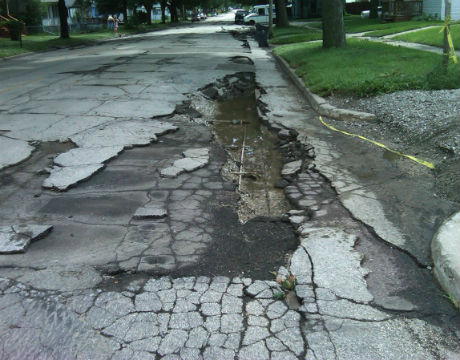Pothole Patching: The Hot and Cold of It
 Like all Midwest cities, Cedar Rapids grapples with severe winter weather and periods of extreme freeze/thaw cycles. During the winter and spring, temperature variations are extreme and moisture seeps into the pavement and freezes, popping pavement loose and causing potholes. City crews tackle potholes differently depending on the time of year, the material available, and the severity of the pavement decay.
Like all Midwest cities, Cedar Rapids grapples with severe winter weather and periods of extreme freeze/thaw cycles. During the winter and spring, temperature variations are extreme and moisture seeps into the pavement and freezes, popping pavement loose and causing potholes. City crews tackle potholes differently depending on the time of year, the material available, and the severity of the pavement decay.
Winter pothole patching and summer pothole patching are as different as night and day. Or more accurately: hot and cold.
Cold Mix
Used primarily during the fall, winter, and early spring months, a cold mix consists of loose asphalt that is temporarily packed into potholes. During the winter when hot asphalt mix is not available, crews pack potholes with a flexible, loose mix that doesn’t harden or adhere to the surrounding pavement. Moisture easily seeps in, freezes, and pops the material and surrounding pavement back out – creating a repetitive and time-consuming patching job for street crews.
Staff fill a pothole with loose mix and then roll it – either by hand or with small compactors – to compress it as tightly as possible. Cold mix serves as a temporary solution; crews use it primarily to keep roads serviceable and to keep water off the base of the pavement.
While there are some challenges with cold mix, it’s available year-round and can be stockpiled for emergency repairs. Cold mix is also quick and easy to apply, so the road can be re-opened to traffic more quickly.
Hot Mix
Hot asphalt is heated and installed at higher temperatures, which hardens as it cools. This mixture – available during the summer – is weather resistant and can be used for permanent solutions called a “point repair.”
When making a point repair, crews mill down the pavement in a square or rectangular area (similar to when you would cut out a clean shape when patching a hole in drywall). A sticky tack is installed to keep the hot mix in place, and then the hole is filled and rolled with a two-ton roller, providing a smooth, well-compacted surface.
Hot mix point repairs require more equipment and additional time for cooling, which often requires longer traffic impacts than cold mix. The long-term benefit is a permanent repair that does not require additional patching maintenance. Point repairs typically last longer than the neighboring pavement.
In the Cedar Rapids area, crews have two asphalt plants available to purchase hot mix. To keep the asphalt hot during the commute from the asphalt plant to the job site, City trucks are equipped with a “hot box” on the back of the truck that keeps the material warm until it can be applied to the pavement.
While pothole patching is an important public service, through Paving for Progress, more roads are getting the attention they need before potholes begin to form.
REPORT A POTHOLE
See a pothole? Let us know!



